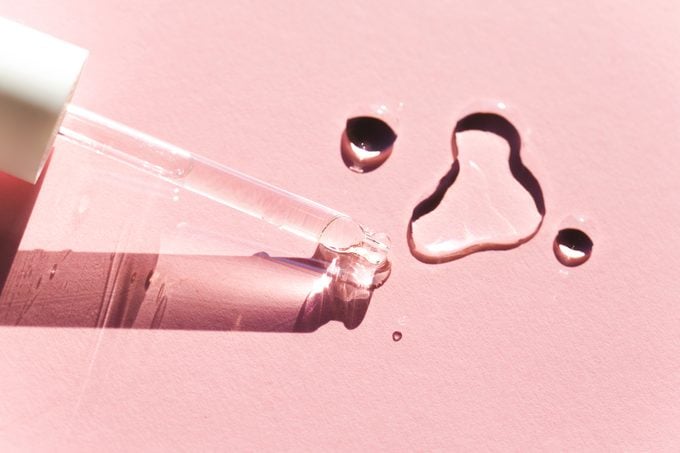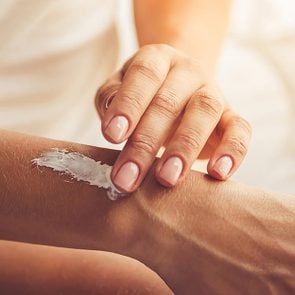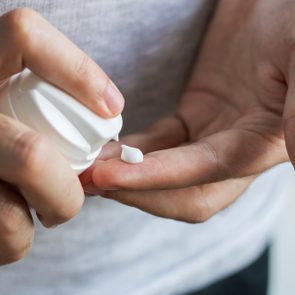10 Things Skin Experts Want You to Know About Hyaluronic Acid
Updated: May 18, 2021
Hyaluronic acid is a popular moisturizing ingredient in skin care products—but is it worth the hype? We asked dermatologists and skin experts.
What is hyaluronic acid?
You wash with a gentle cleanser, slather on moisturizer, dab on face oil … and yet you’re still fighting dry skin? If you’re struggling to keep your skin hydrated, you may want to add hyaluronic acid to your routine. Don’t let the “acid” in its name put you off. It’s actually something of a miracle moisturizer.
“Hyaluronic acid is a sugar molecule that is naturally occurring in skin and other types of human tissue,” says Nancy Samolitis, MD, a board-certified dermatologist and owner of Facile Dermatology and Boutique in West Hollywood, California. “It has a jelly-like texture and holds over 1,000 times its weight in water, therefore creating plumpness and hydration in the skin.”
When used properly, some forms of hyaluronic acid can be extremely effective for preventing water loss in dry skin.
Read on to find out what dermatologists and skin care experts want you to know about hyaluronic acid, including how it works, how to use it, and potential risks and side effects.
How does hyaluronic acid work?
Think of hyaluronic acid as a sort of magnet, drawing water to it and making sure it doesn’t evaporate from your skin. That “makes it hydrating and effective at treating transepidermal water loss, or dehydration,” says Karen Fernandez, lead aesthetician for SkinSpirit clinics.
Although it has the word acid in it, hyaluronic acid doesn’t act like an exfoliator. “I think of hyaluronic acid like thick water serum,” says Fernandez.
(These are the best serums for summer.)
Marisa Garshick, MD, a board-certified dermatologist with MDCS Dermatology in New York City, notes that hyaluronic acid works for anti-aging as well as dryness.
“Because hyaluronic acid helps to draw in moisture, not only is it great to help with skin hydration, but it also serves as a way to plump fine lines, wrinkles, and other areas on the face with volume loss, and therefore helps to improve signs of aging and can help give a more refreshed appearance to the skin,” says Dr. Garshick, who is also a clinical assistant professor of dermatology at Weill Cornell Medicine.
Where does hyaluronic acid show up in the body?
You’ll find hyaluronic acid throughout the body, though it’s more abundant in some areas than others.
“Hyaluronic acid is found in those areas of our body that need moisture and lubrication to function and is most common in the eyes, skin, and joints,” says Flora Waples, MD, medical director of Restor Medical Spa in Denver.
There’s a reason it’s most often associated with skin care. A huge amount of hyaluronic acid resides in the skin.
“This accounts for 50 percent of the total body hyaluronic acid,” says Dr. Garshick. “Within the skin, it can be found in the dermis and epidermis.”
The epidermis is the thinner, top layer of skin—the surface you see and feel. The dermis is the second, thicker layer of skin. This lower layer is where you make sweat and oil, grow hair, and feel things.
The older you get, the more hyaluronic acid your body needs but—and here’s the big downside—the less your body makes.
“It is naturally occurring in our bodies and skin, but with age and the damaging effects of pollutants and sun, our production declines as we get older,” says Fernandez. “Using products that will deliver hyaluronic acid to the skin will help skin have the ability to attract and contain more hydration.”
(Check out The Ordinary’s best anti-aging products.)

How effective is hyaluronic acid?
If you’ve spent any time scanning the shelves of your local beauty emporium, you might have noticed the term hyaluronic acid turning up over and over again. It’s available as serums. It’s added to moisturizers. It’s even showing up in cleansers and masks.
Not only is it popular, but it’s pretty darn effective.
“For some, the result can be nearly immediate because when hyaluronic acid sits on the surface, it draws moisture in to provide an instant boost,” says Dr. Garshick.
Why does it work so well? Chalk it up to hyaluronic acid’s water-retaining ability.
“It’s that ‘1,000 times its weight in water’ ability that truly makes hyaluronic acid such a powerhouse,” says Dr. Waples. “It literally pulls water into your skin and holds it there, as opposed to lipid-based moisturizers, which try to ‘seal’ the outside of the skin to prevent water from evaporating away.”
What are hyaluronic acid injectables?
You can add hyaluronic acid to your skin to boost hydration, but there’s another way to get the ingredient: you can inject it into the skin.
Dermal fillers like Juvederm and Restylane, which are used to plump lips and smooth lines, are made from hyaluronic acid. “That is why, when properly done, they look so natural,” Dr. Waples says.
Of course, these aren’t DIY treatments like a serum you pick up at the pharmacy. They’re in-office procedures.
(These are the best anti-aging products at every price point.)
What are hyaluronic acid supplements?
Most people use topical hyaluronic acid—you know, the serums, creams, and lotions you rub onto your face. But you can also take it orally.
Oral supplements of hyaluronic acid promise to plump skin from the inside. While studies on the effectiveness of these supplements show promise, few have drawn a line between supplemental hylauronic acid and skin hydration. Researchers have, however, looked at the association between oral hyaluronic acid and knee pain.
A 2016 article in Nutrition Journal reviewing multiple hyaluronic acid trials between 2008 and 2015 observed that studies “clearly suggest hyaluronic acid is absorbed by the body.” The studies found that the supplement can help reduce knee pain.
And a study published in The Scientific World Journal found that hyaluronic acid taken orally helped improve the symptoms of knee osteoarthritis in patients younger than 70.
Kelly Bickle, MD, a dermatologist in Santa Monica, California, believes hyaluronic acid can have positive skin care results when taken as a supplement.
“Oral supplementation of hyaluronic acid is beneficial in terms of hydrating the skin, which gives an appearance of fewer wrinkles and therefore a less-aged appearance,” she says. “Studies showed uptake into the skin of the hyaluronic acid when ingested orally—not a huge amount, but significant enough to show clinically some improvement in the appearance of skin hydration.”
(These are the anti-aging supplements doctors recommend.)
Risks and side effects of hyaluronic acid
Most people won’t have any problems using hyaluronic acid.
“Because hyaluronic acid is naturally found in the skin, it has a lower chance of causing skin sensitivity or allergic reactions,” says Zain Husain, MD, a board-certified dermatologist and founder of New Jersey Dermatology and Aesthetics Center in Marlboro, New Jersey.
And while it’s touted as a holy grail for dry skin, pretty much anyone can use it. (Yes, even people with oily skin.)
Still, it’s best to pay attention for any signs of irritation.
“If you do experience side effects—like redness, itching, or swelling—when using hyaluronic acid topically, make sure to discontinue the use of your product and consult your dermatologist,” Dr. Husain says.
Dr. Garshick cautions people with rosacea-prone skin to incorporate it gradually to avoid sensitivity.
As for hyaluronic acid fillers, discuss potential side effects with your doctor before going under the needle. “It is important to remember that all fillers can have potential side effects, including bruising, swelling, and the rare but possible risk of blood vessel occlusion,” says Dr. Garshick.
How to choose the best hyaluronic acid
Check a hyaluronic acid product’s label, and you’ll probably see a percentage (generally 1 to 2 percent, Dr. Garshick says). That refers to the concentration of hyaluronic acid, and higher isn’t always better.
“A higher strength of hyaluronic acid doesn’t necessarily make it more effective,” Dr. Garshick says. Unlike other skin care ingredients, hyaluronic acid is less about strength and more about the weight of the molecules.
Look for hyaluronic acid serums and moisturizers with lower molecular weights, which may be able to penetrate more deeply. Those with higher molecular weights, which sit on the surface of the skin, may give you immediate moisture but don’t offer long-lasting benefits.
Here’s where it gets tricky. Not every hyaluronic acid product says its molecular weight. In fact, most don’t. But you can look for phrases like “low molecular weight” or “multi-molecular weight,” which refers to a mix of molecular weights.
How to use hyaluronic acid properly
Dry skin? Check.
A burning desire to show your skin the meaning of “moisturized”? Double-check.
Let’s do this.
Apply regularly
Some skin care ingredients can only be applied once a day—or less—because they can cause irritation. (We’re looking at you, retinol.) Not hyaluronic acid, though.
“In general, depending on the specific formulation, hyaluronic acid can be used one to two times daily and can be used in the morning or night,” Dr. Garshick says.
Fernandez recommends applying it twice a day.
“Think of it as the drink of water for your skin for the day and then another for the night,” she says. “When the skin has had its water—delivered deep into dermal tissues, ideally—it can function at its very best: making new cells and cycling out the old ones.”
Apply to damp skin
Remember how hyaluronic acid can dry out skin if used improperly? Not such a great outcome when you slathered on the stuff in order to beat dryness. That’s why experts swear by this super-simple trick: apply hyaluronic acid when the skin is damp.
Remember, hyaluronic acid attracts moisture. If there’s none in the air, guess where it’s taking it from. You got it: your skin. “In fact, if it draws too much moisture away from the skin, it can actually paradoxically dry the skin out,” says Dr. Garshick.
Add it to damp skin, however, and your skin will absorb maximum moisture. If you’re using a hyaluronic acid serum, put it on damp skin, then layer on a cream, lotion, or oil to seal in the moisture.
Combine with other products
According to Fernandez, hyaluronic acid doesn’t have to be used with a retinoid (an anti-aging powerhouse derived from vitamin A ), but they’re stronger together than separate.
“Retinol will help build up the dermal layer—what I call the engine room of your skin—and by thickening that layer, you will have more collagen and elastin fibers being reproduced and more space for more hyaluronic acid molecules to land and do their magic,” she says.
Celebrity aesthetician Sonya Dakar, founder of Sonya Dakar (a skin care line) and the Sonya Dakar Skin Clinic, loves to combine hyaluronic acid with another skin care superstar. “Hyaluronic acid works really well with vitamin C.”
Mixing hyaluronic acid with other products
Experts agree that hyaluronic acid doesn’t have negative interactions with other skin care products. In fact, Dr. Garshick notes that it usually has positive interactions.
“It tends to work well with other skin care ingredients as it hydrates the skin, potentially helping to make other products and ingredients more tolerable,” Dr. Garshick says.
Dr. Waples agrees. “It will augment any moisturizer that you combine it with, and it has no negative interactions with any other skin care products,” she says.
Next, check out these natural moisturizers you can find at home

















